Korean Fish Cake Soup (Kkochi Eomuk-Tang)
Korean fish cake soup (eomuk tang) served on skewers is ideal for cold weather. This easy recipe, with its dashi and radish broth, brings Korean street vendor flavors to your table. Don’t forget the dipping sauce!
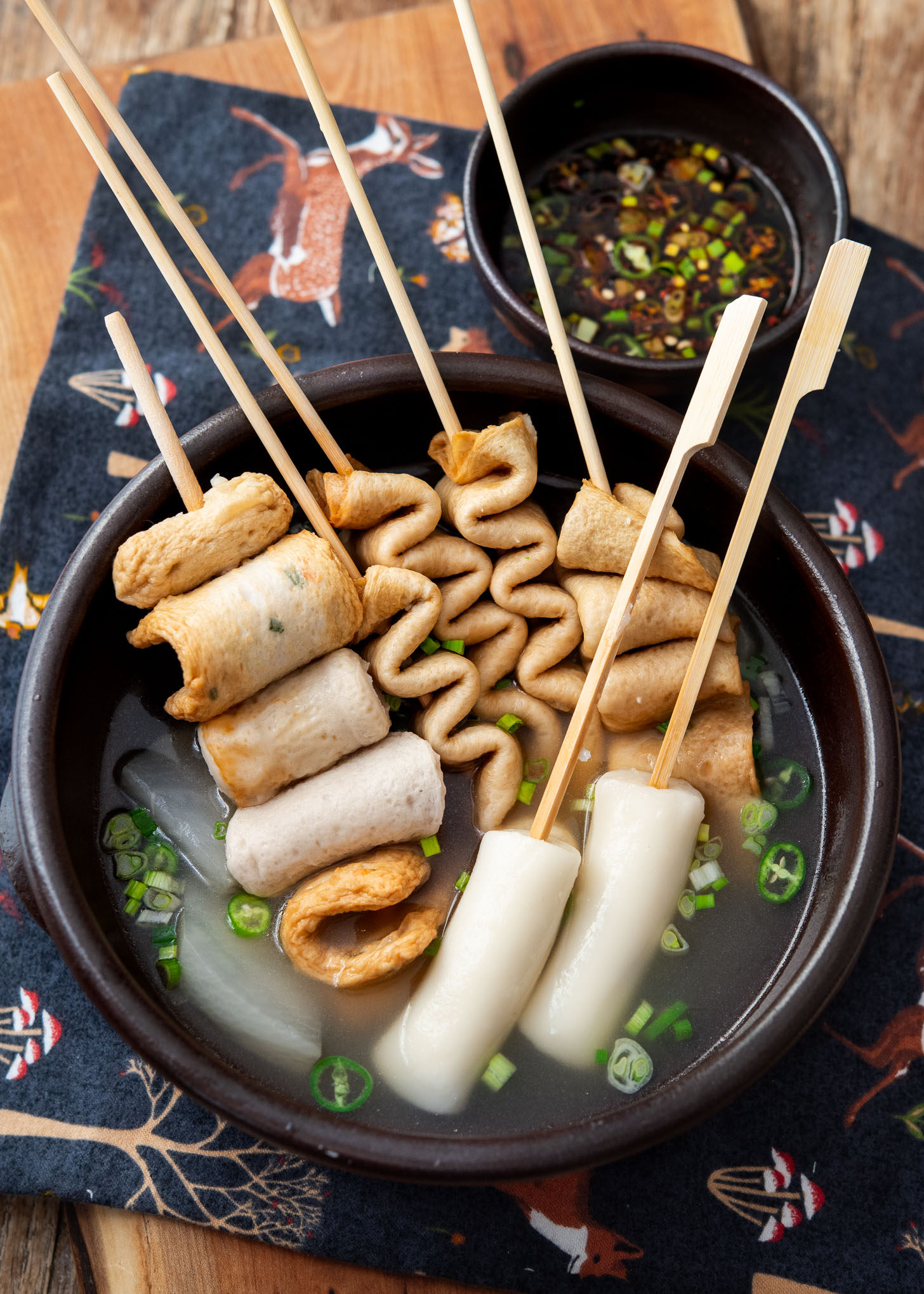
When the weather turns cold, numerous food stalls selling fish cake soup, known as eomuk tang, appear on the streets of Korea. Skewered on long wooden sticks and simmered in a hot flavorful stock, these Korean fish cakes are a popular snack during the chilly winter months.
They are simple to make at home and offer a comforting experience, with their hot broth brimming with umami.
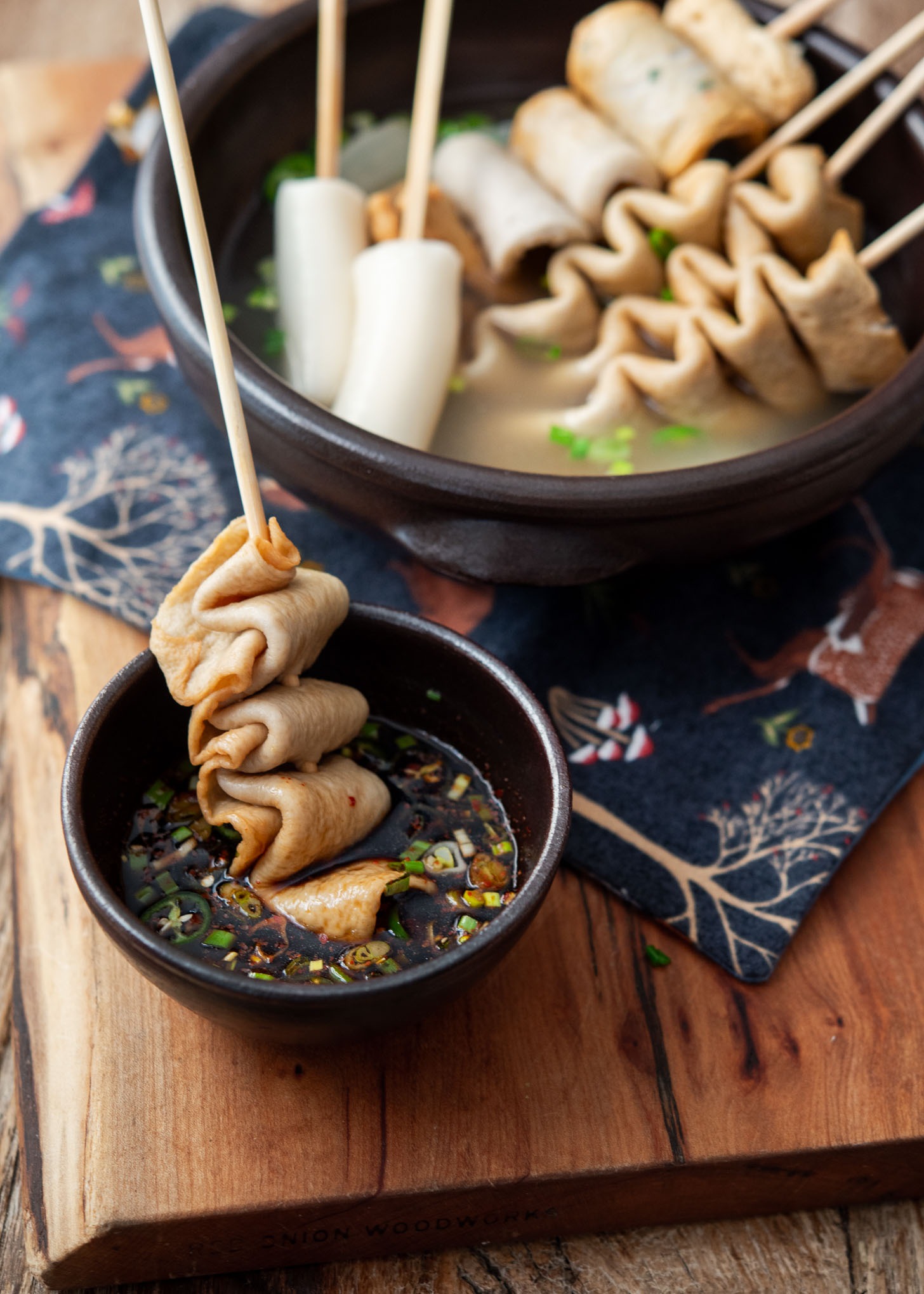
What is Korean fish cakes made of?
Korean fish cakes, called “Eomuk” or “Odeng,” are mainly made from ground white fish and flour or starch. They also have salt, sugar, and different seasonings. Sometimes, they include chopped vegetables like carrots or green onions.
The fish meat and other ingredients are mixed into a paste, shaped into various forms, and then cooked by frying, boiling, or steaming. These fish cakes are commonly used in Korean soups, such as eomuk guk (or odeng guk).
You will also find fish cakes used in tteokbokki (spicy Korean rice cakes) or eomuk bokkeum (fish cake stir-fry), a common Korean banchan.
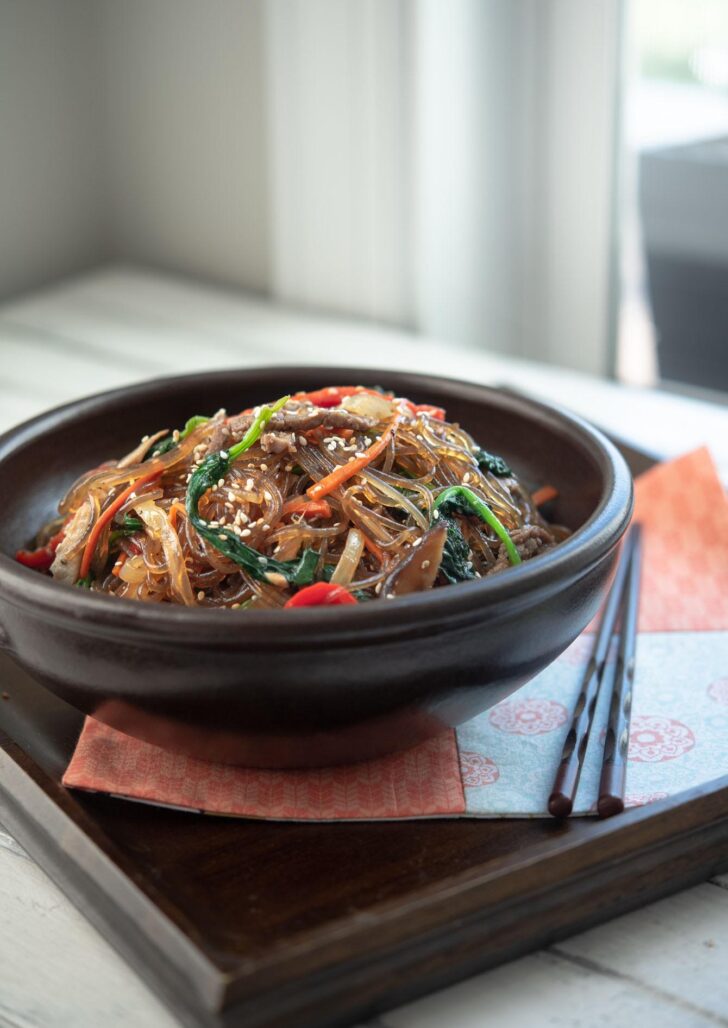
Get new recipes via email:
Recipe Ingredients & Sources
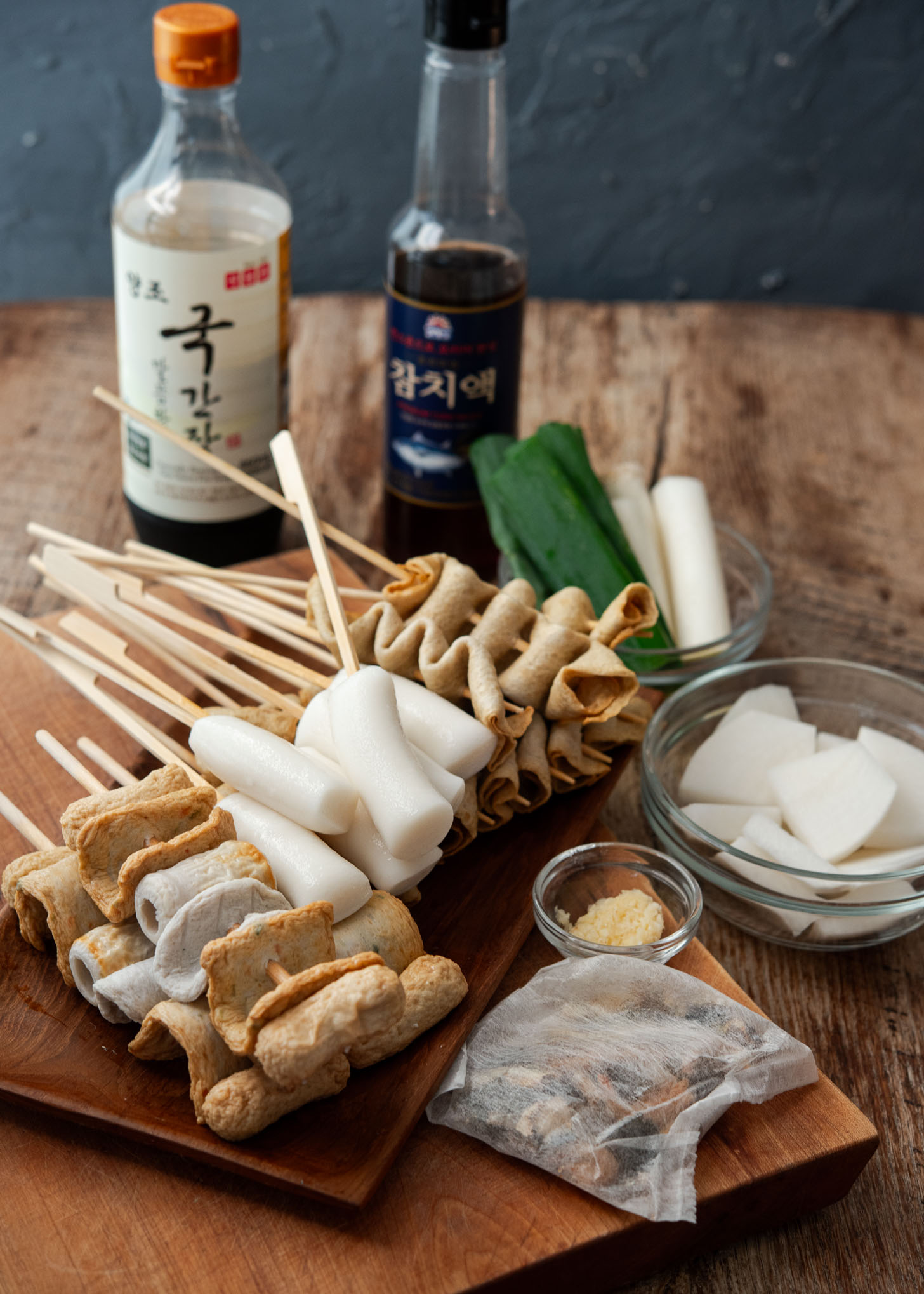
- Pre-packaged Fish Cake Skewers: These skewered fish cakes are ready to cook and you can find them in various shapes and types in the freezer section of Korean grocery stores. I usually opt for flat fish cake sheets rolled up on wooden skewers and round fish cake varieties.
- They often come with a soup broth seasoning packet, but making the broth from scratch usually yields better taste.
- If you can’t find the pre-packaged skewered fish cakes, you can always buy fish cakes separately and skewer them yourself.
- Rice Cakes (optional): Long rice cakes, known as ‘garae tteok’, add a nice chewy texture to the dish and are great for dipping in the sauce.
- Korean Radish: Radish slices enhance the broth’s flavor when simmered together, so I recommend not to skip this ingredient.
- Anchovy Soup Stock Pack: This is a convenient dashi pack that combines all necessary ingredients. You can find it at any Korean or Asian grocery store, or online.
- Alternatively, you can make anchovy stock from scratch easily. See my how to make anchovy stock.
- Asian Leek: This adds flavor to the stock. If unavailable, you can substitute with onion or regular leek.
- Stock Seasoning: This includes Korean soup soy sauce, Korean tuna sauce, garlic, salt, and black pepper.
- If you can’t find Korean tuna sauce, substitute with tsuyu (Japanes soup base sauce)
- Skewers (kkochi): Using skewers is optional when making eomuk guk with cut fish cakes. Skewers offer a convenient way to eat the fish cakes without utensils, similar to how Korean street vendors serve. This skewered version is what we call, eomuk tang.
- If opting for skewers, ensure they are sturdy enough to support the fish cakes. You can use wooden skewers specifically designed for this, or alternatively, repurpose wooden chopsticks.
For the Dipping Sauce:
- Soy sauce, water, Korean chili flakes (gochugaru), vinegar, green onion, and optionally green chili.
How to make Korean fish cake soup
Optional Rice Cake Preparation
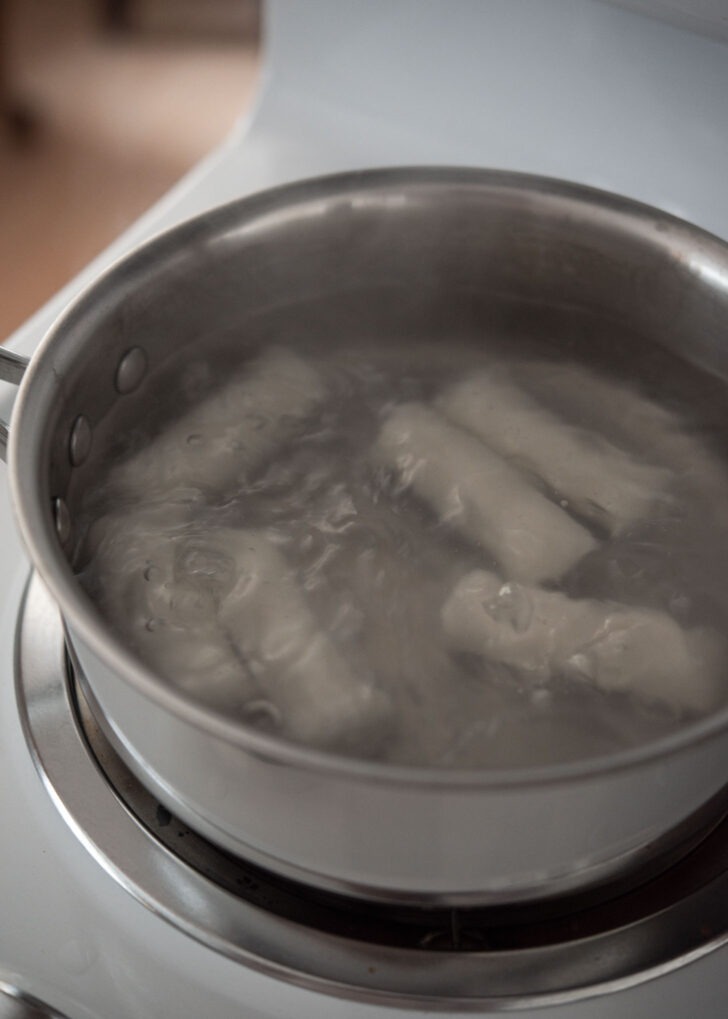
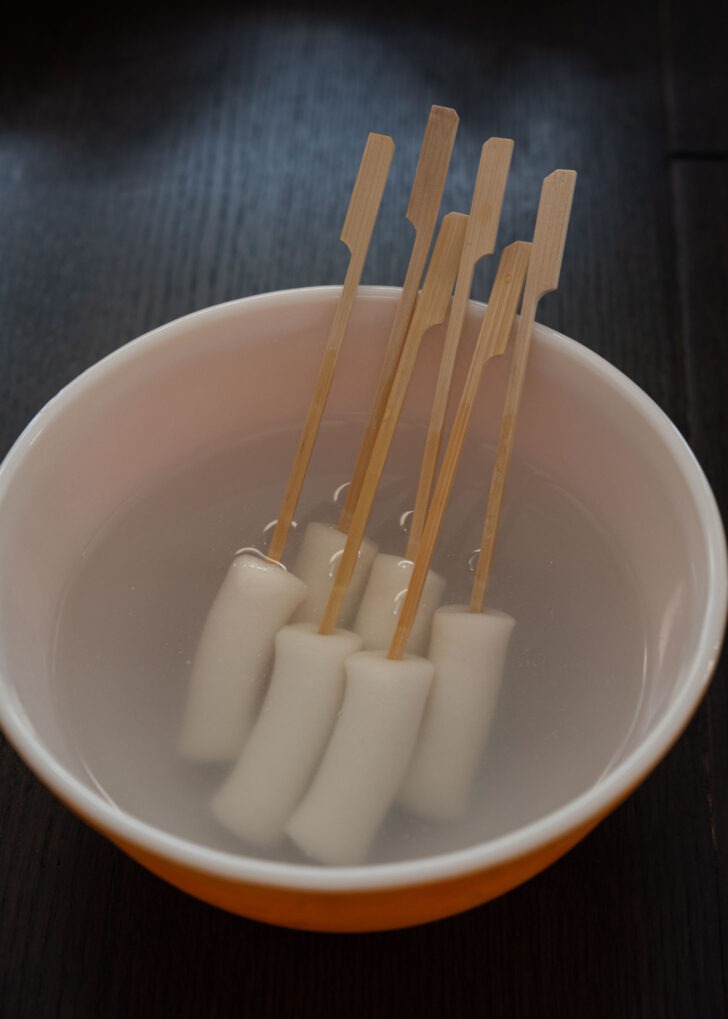
- In a pot, boil water over medium heat. Add rice cake logs, cooking for 1-2 minutes until they are soft and tender. Drain and rinse the rice cakes with cold water to cool them slightly.
- Once warm to the touch, thread them onto long skewers. Soak them in water and set aside.
Soup Preparation
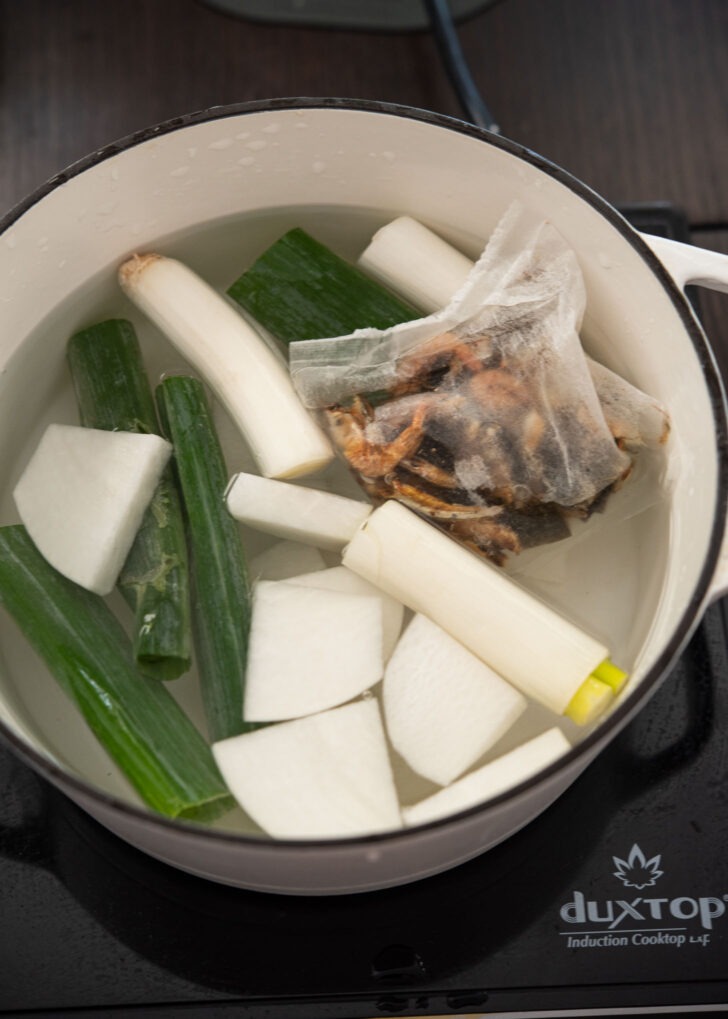
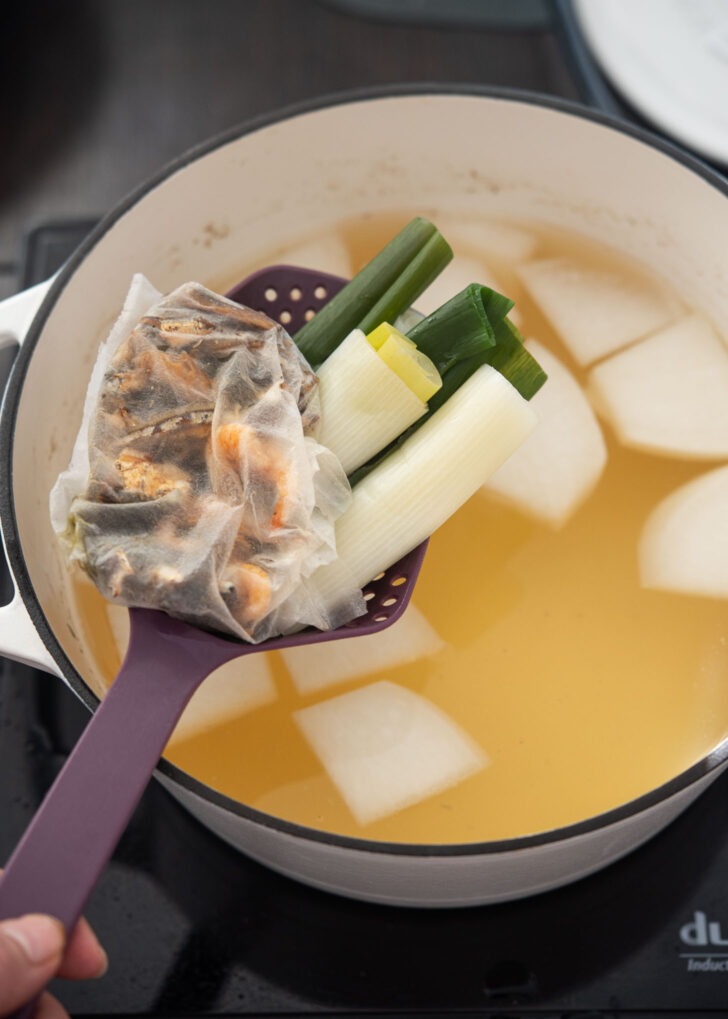
- In a 4-quart soup pot, combine 7 cups of water, anchovy stock dashi packet, sliced Korean radish, and Asian leek. Bring to a boil, then reduce heat to low and simmer for 10 minutes.
- Remove and discard the stock packet and leek, keeping the radish in the stock.
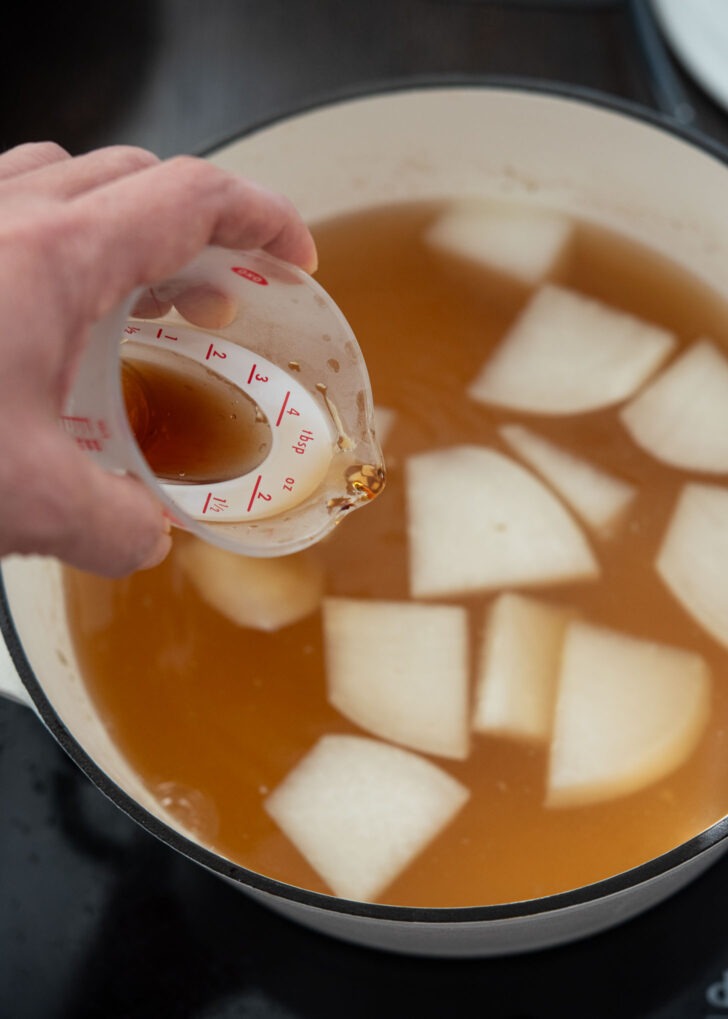
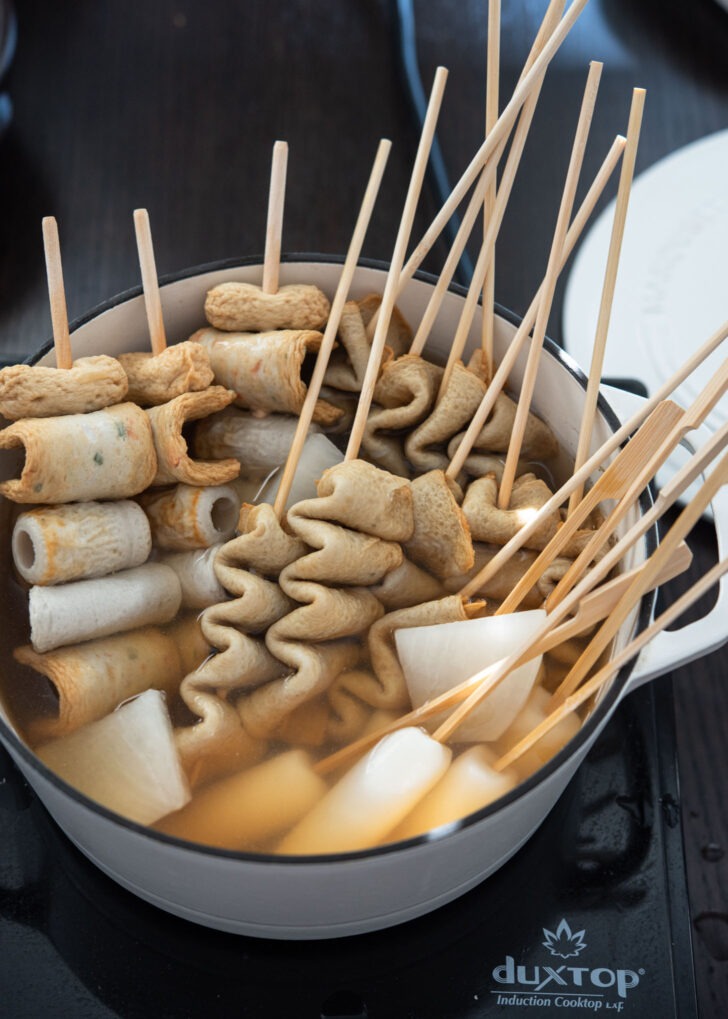
- Season the boiled stock with Korean soup soy sauce, tuna sauce (or tsuyu), salt, garlic, and pepper to taste.
- Add fish cake skewers and rice cake skewers to the pot. It’s fine if the skewers aren’t fully submerged. Occasionally ladle the hot broth over any exposed parts of the fish cakes as they simmer.
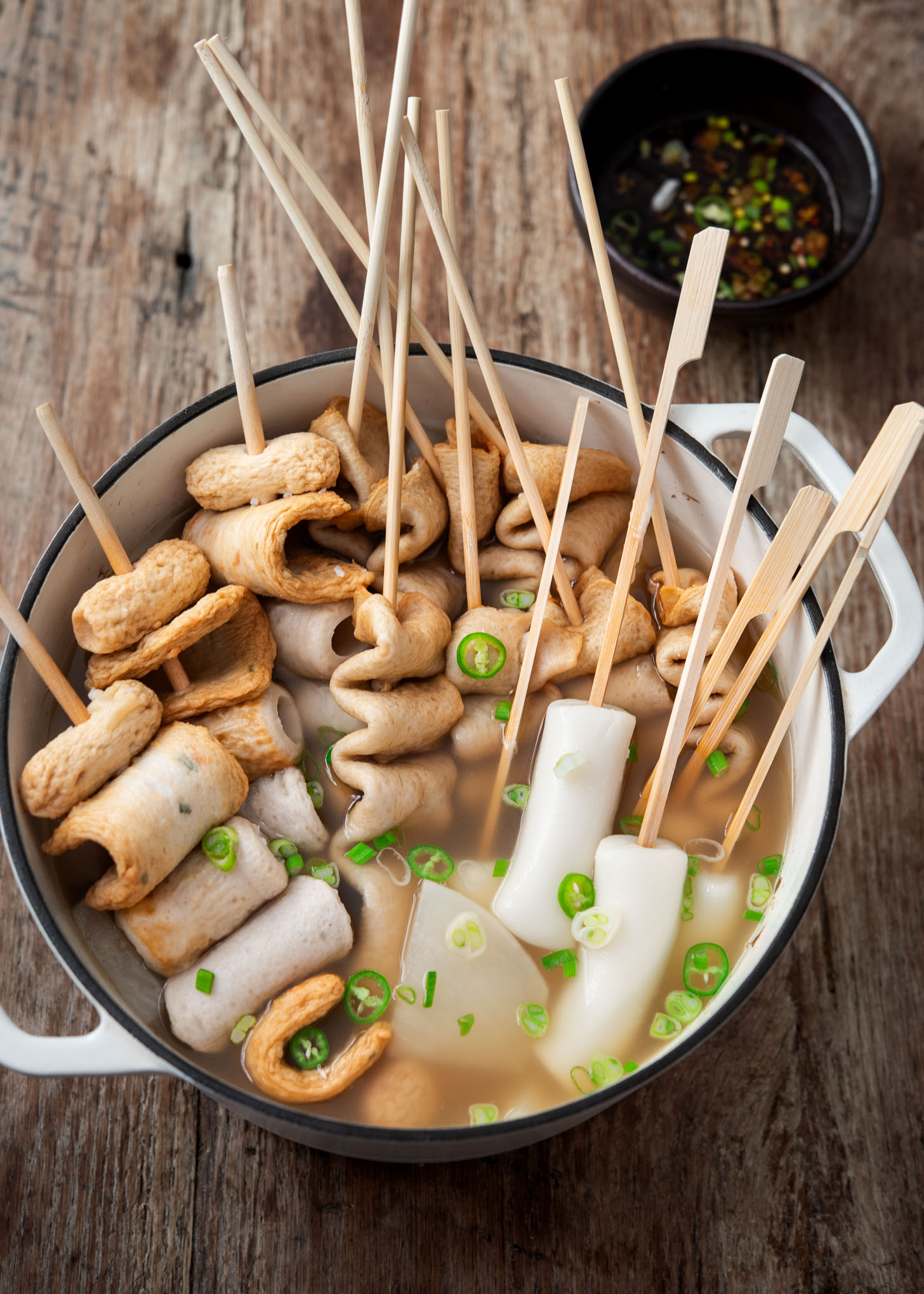
- Once the fish cakes puff up slightly, the soup is ready to serve. Garnish with green onion and fresh chili to add a. hint of spicy kick. Enjoy hot with the prepared dipping sauce.
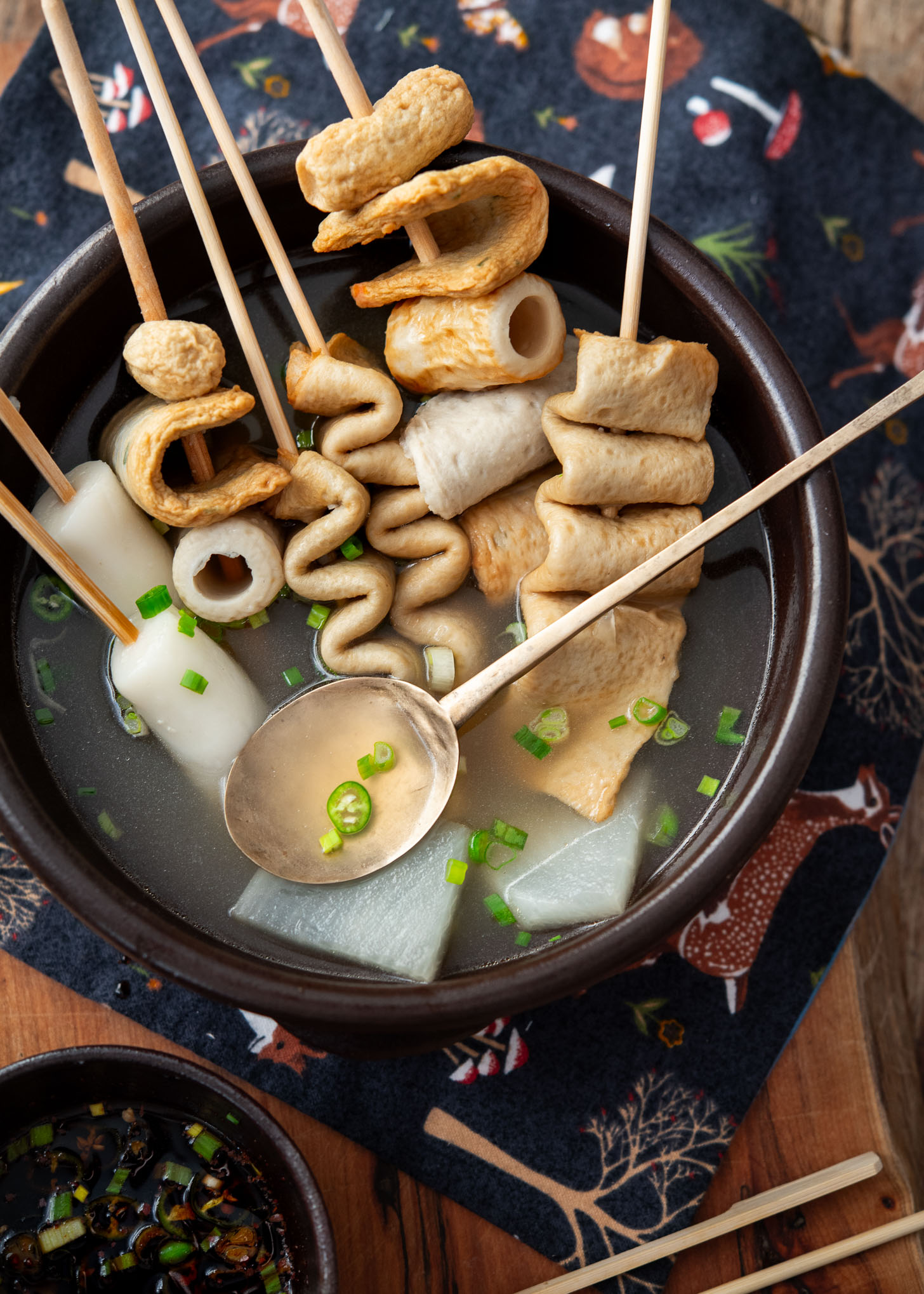
Related Recipes
- Galbitang Recipe (Korean Short Rib Soup)
- Tuna Sundubu Jjigae
- Jjamppong (Korean Seafood Noodle Soup)
- Korean Fish Cake and Vegetable Side Dish
Love this recipe? Rate it and share your experience in the comments below! On Instagram? Tag me to showcase your creation. For more delicious recipes, subscribe to our newsletter!
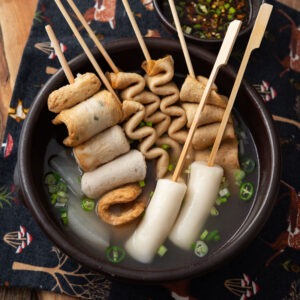
Korean Fish Cake Soup (Eomuk-Tang)
Ingredients
- 10 oz (300 g) flat fish cakes, skewered
- 10 oz (300 g) round fish cakes, skewered
- 7 oz (200 g) rice cake logs, optional
- 2 green onion, chopped
- 1 fresh chili, finely sliced
For soup broth
- 7 cups (1.6 liter) water
- 1 packet Korean soup stock dashi bag, see note below
- 7 oz (200 g) Korean radish, sliced into 1/4-inch pieces
- 1 tbsp Korean soup soy sauce
- 1/2 tbsp Korean tuna sauce, or tsuyu
- 1/2 tbsp minced garlic
- salt and pepper , to taste
For dipping sauce
- 3 tbsp soy sauce
- 1 1/2 tbsp water
- 1/2 tbsp Korean chili flakes (gochugaru)
- 1 tbsp rice vinegar
- 2 tbsp chopped green onion
- 1 tbsp chopped fresh chili, optional
Equipment
- 4-quart soup pot
Instructions
To prepare rice cakes (optional)
- In a pot, boil water over medium heat. Add rice cake logs, cooking for 1-2 minutes until they are soft and tender. Drain and rinse the rice cakes with cold water to cool them slightly. Once warm to the touch, thread them onto long skewers. Soak them in water and set aside.
To make the soup broth
- In a 4-quart soup pot, combine 7 cups of water, anchovy stock dashi packet, sliced Korean radish, and Asian leek. Bring to a boil, then reduce heat to low and simmer for 10 minutes. Remove and discard the stock packet and leek, keeping the radish in the stock.
- Season the boiled stock with Korean soup soy sauce, tuna sauce (or tsuyu), salt, garlic, and pepper to taste.
To make fish cake soup
- Add fish cake skewers and rice cake skewers to the pot. It's fine if the skewers aren't fully submerged. Occasionally ladle the hot broth over any exposed parts of the fish cakes as they simmer.
- Once the fish cakes puff up slightly, the soup is ready to serve. Garnish with green onion and fresh chili to add a hint of spicy kick. Enjoy hot with the prepared dipping sauce.
To make the dipping sauce
- Combine all sauce ingredients in a bowl. Mix well and set aside for serving.

